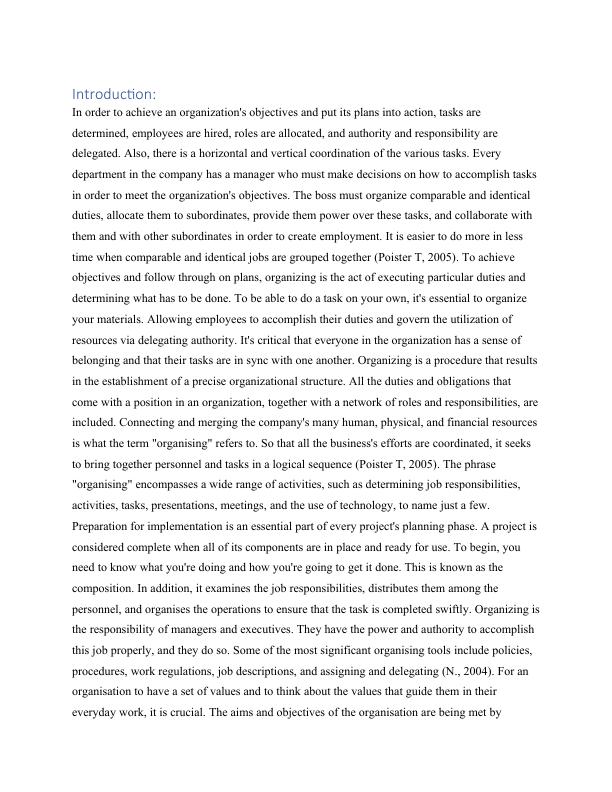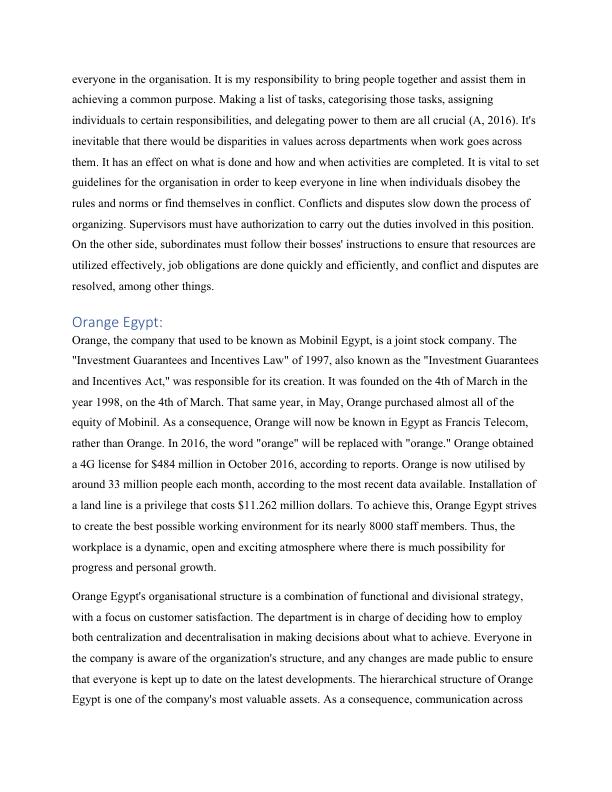Essay on Business Analysis of Orange Egypt
Added on 2022-05-02
5 Pages2144 Words30 Views
Introduction:
In order to achieve an organization's objectives and put its plans into action, tasks are
determined, employees are hired, roles are allocated, and authority and responsibility are
delegated. Also, there is a horizontal and vertical coordination of the various tasks. Every
department in the company has a manager who must make decisions on how to accomplish tasks
in order to meet the organization's objectives. The boss must organize comparable and identical
duties, allocate them to subordinates, provide them power over these tasks, and collaborate with
them and with other subordinates in order to create employment. It is easier to do more in less
time when comparable and identical jobs are grouped together (Poister T, 2005). To achieve
objectives and follow through on plans, organizing is the act of executing particular duties and
determining what has to be done. To be able to do a task on your own, it's essential to organize
your materials. Allowing employees to accomplish their duties and govern the utilization of
resources via delegating authority. It's critical that everyone in the organization has a sense of
belonging and that their tasks are in sync with one another. Organizing is a procedure that results
in the establishment of a precise organizational structure. All the duties and obligations that
come with a position in an organization, together with a network of roles and responsibilities, are
included. Connecting and merging the company's many human, physical, and financial resources
is what the term "organising" refers to. So that all the business's efforts are coordinated, it seeks
to bring together personnel and tasks in a logical sequence (Poister T, 2005). The phrase
"organising" encompasses a wide range of activities, such as determining job responsibilities,
activities, tasks, presentations, meetings, and the use of technology, to name just a few.
Preparation for implementation is an essential part of every project's planning phase. A project is
considered complete when all of its components are in place and ready for use. To begin, you
need to know what you're doing and how you're going to get it done. This is known as the
composition. In addition, it examines the job responsibilities, distributes them among the
personnel, and organises the operations to ensure that the task is completed swiftly. Organizing is
the responsibility of managers and executives. They have the power and authority to accomplish
this job properly, and they do so. Some of the most significant organising tools include policies,
procedures, work regulations, job descriptions, and assigning and delegating (N., 2004). For an
organisation to have a set of values and to think about the values that guide them in their
everyday work, it is crucial. The aims and objectives of the organisation are being met by
In order to achieve an organization's objectives and put its plans into action, tasks are
determined, employees are hired, roles are allocated, and authority and responsibility are
delegated. Also, there is a horizontal and vertical coordination of the various tasks. Every
department in the company has a manager who must make decisions on how to accomplish tasks
in order to meet the organization's objectives. The boss must organize comparable and identical
duties, allocate them to subordinates, provide them power over these tasks, and collaborate with
them and with other subordinates in order to create employment. It is easier to do more in less
time when comparable and identical jobs are grouped together (Poister T, 2005). To achieve
objectives and follow through on plans, organizing is the act of executing particular duties and
determining what has to be done. To be able to do a task on your own, it's essential to organize
your materials. Allowing employees to accomplish their duties and govern the utilization of
resources via delegating authority. It's critical that everyone in the organization has a sense of
belonging and that their tasks are in sync with one another. Organizing is a procedure that results
in the establishment of a precise organizational structure. All the duties and obligations that
come with a position in an organization, together with a network of roles and responsibilities, are
included. Connecting and merging the company's many human, physical, and financial resources
is what the term "organising" refers to. So that all the business's efforts are coordinated, it seeks
to bring together personnel and tasks in a logical sequence (Poister T, 2005). The phrase
"organising" encompasses a wide range of activities, such as determining job responsibilities,
activities, tasks, presentations, meetings, and the use of technology, to name just a few.
Preparation for implementation is an essential part of every project's planning phase. A project is
considered complete when all of its components are in place and ready for use. To begin, you
need to know what you're doing and how you're going to get it done. This is known as the
composition. In addition, it examines the job responsibilities, distributes them among the
personnel, and organises the operations to ensure that the task is completed swiftly. Organizing is
the responsibility of managers and executives. They have the power and authority to accomplish
this job properly, and they do so. Some of the most significant organising tools include policies,
procedures, work regulations, job descriptions, and assigning and delegating (N., 2004). For an
organisation to have a set of values and to think about the values that guide them in their
everyday work, it is crucial. The aims and objectives of the organisation are being met by

everyone in the organisation. It is my responsibility to bring people together and assist them in
achieving a common purpose. Making a list of tasks, categorising those tasks, assigning
individuals to certain responsibilities, and delegating power to them are all crucial (A, 2016). It's
inevitable that there would be disparities in values across departments when work goes across
them. It has an effect on what is done and how and when activities are completed. It is vital to set
guidelines for the organisation in order to keep everyone in line when individuals disobey the
rules and norms or find themselves in conflict. Conflicts and disputes slow down the process of
organizing. Supervisors must have authorization to carry out the duties involved in this position.
On the other side, subordinates must follow their bosses' instructions to ensure that resources are
utilized effectively, job obligations are done quickly and efficiently, and conflict and disputes are
resolved, among other things.
Orange Egypt:
Orange, the company that used to be known as Mobinil Egypt, is a joint stock company. The
"Investment Guarantees and Incentives Law" of 1997, also known as the "Investment Guarantees
and Incentives Act," was responsible for its creation. It was founded on the 4th of March in the
year 1998, on the 4th of March. That same year, in May, Orange purchased almost all of the
equity of Mobinil. As a consequence, Orange will now be known in Egypt as Francis Telecom,
rather than Orange. In 2016, the word "orange" will be replaced with "orange." Orange obtained
a 4G license for $484 million in October 2016, according to reports. Orange is now utilised by
around 33 million people each month, according to the most recent data available. Installation of
a land line is a privilege that costs $11.262 million dollars. To achieve this, Orange Egypt strives
to create the best possible working environment for its nearly 8000 staff members. Thus, the
workplace is a dynamic, open and exciting atmosphere where there is much possibility for
progress and personal growth.
Orange Egypt's organisational structure is a combination of functional and divisional strategy,
with a focus on customer satisfaction. The department is in charge of deciding how to employ
both centralization and decentralisation in making decisions about what to achieve. Everyone in
the company is aware of the organization's structure, and any changes are made public to ensure
that everyone is kept up to date on the latest developments. The hierarchical structure of Orange
Egypt is one of the company's most valuable assets. As a consequence, communication across
achieving a common purpose. Making a list of tasks, categorising those tasks, assigning
individuals to certain responsibilities, and delegating power to them are all crucial (A, 2016). It's
inevitable that there would be disparities in values across departments when work goes across
them. It has an effect on what is done and how and when activities are completed. It is vital to set
guidelines for the organisation in order to keep everyone in line when individuals disobey the
rules and norms or find themselves in conflict. Conflicts and disputes slow down the process of
organizing. Supervisors must have authorization to carry out the duties involved in this position.
On the other side, subordinates must follow their bosses' instructions to ensure that resources are
utilized effectively, job obligations are done quickly and efficiently, and conflict and disputes are
resolved, among other things.
Orange Egypt:
Orange, the company that used to be known as Mobinil Egypt, is a joint stock company. The
"Investment Guarantees and Incentives Law" of 1997, also known as the "Investment Guarantees
and Incentives Act," was responsible for its creation. It was founded on the 4th of March in the
year 1998, on the 4th of March. That same year, in May, Orange purchased almost all of the
equity of Mobinil. As a consequence, Orange will now be known in Egypt as Francis Telecom,
rather than Orange. In 2016, the word "orange" will be replaced with "orange." Orange obtained
a 4G license for $484 million in October 2016, according to reports. Orange is now utilised by
around 33 million people each month, according to the most recent data available. Installation of
a land line is a privilege that costs $11.262 million dollars. To achieve this, Orange Egypt strives
to create the best possible working environment for its nearly 8000 staff members. Thus, the
workplace is a dynamic, open and exciting atmosphere where there is much possibility for
progress and personal growth.
Orange Egypt's organisational structure is a combination of functional and divisional strategy,
with a focus on customer satisfaction. The department is in charge of deciding how to employ
both centralization and decentralisation in making decisions about what to achieve. Everyone in
the company is aware of the organization's structure, and any changes are made public to ensure
that everyone is kept up to date on the latest developments. The hierarchical structure of Orange
Egypt is one of the company's most valuable assets. As a consequence, communication across

End of preview
Want to access all the pages? Upload your documents or become a member.
Related Documents
Leadership and Management: Past, Present and Futurelg...
|21
|1778
|67
Influence of Organisational Culture, Power and Politics on Individuals and Team Behaviourlg...
|15
|4759
|41
Role of HR and Theorieslg...
|7
|1379
|100
Management and Leadership Perspectives: A Reflective Reportlg...
|7
|1382
|55
Analysis of Gig Economylg...
|10
|2948
|39
Introduction to Management - Functions, Levels, and Historylg...
|6
|864
|400
